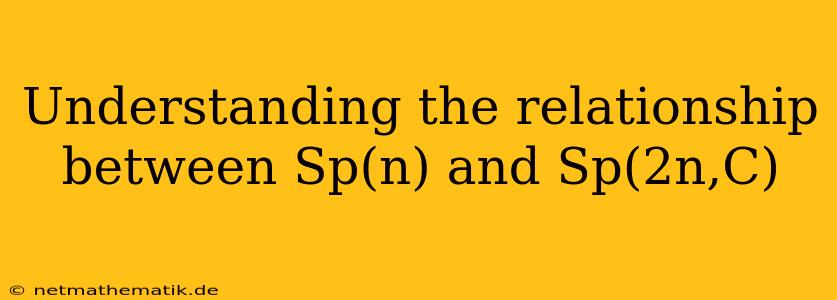The study of Lie groups and their representations is a fundamental area of mathematics with broad applications in physics, geometry, and other fields. Among the many important Lie groups, the symplectic groups, denoted by Sp(n) and Sp(2n,C), play a crucial role due to their connections with classical mechanics, quantum mechanics, and the theory of differential forms. This article will delve into the intricate relationship between these two groups, exploring their definitions, key properties, and the ways in which they intertwine. We will see how the complex symplectic group Sp(2n,C) can be understood as a complexification of the real symplectic group Sp(n), highlighting the parallels and differences between their structures and representations.
Defining the Symplectic Groups
The symplectic groups are defined in terms of their actions on vector spaces equipped with a non-degenerate skew-symmetric bilinear form. Let's start with the real symplectic group Sp(n), which is the group of all linear transformations on a real vector space R^2n that preserve a particular skew-symmetric bilinear form. This form, often denoted by ω, is defined as follows: for vectors x = (x1, ..., x2n) and y = (y1, ..., y2n) in R^2n,
ω(x,y) = x^T J y = (x1 y2 - x2 y1) + (x3 y4 - x4 y3) + ... + (x2n-1 y2n - x2n y2n-1),
where J is the 2n x 2n skew-symmetric matrix
J =
[0 I]
[-I 0]
where I is the n x n identity matrix.
A linear transformation A on R^2n is in Sp(n) if and only if it preserves ω, meaning that
ω(Ax, Ay) = ω(x,y)
for all vectors x,y in R^2n. This condition can be expressed in terms of matrices as follows:
A^T J A = J.
This equation is the defining relation for Sp(n), and it encodes the fundamental property that Sp(n) transformations preserve the symplectic form ω.
Moving on to the complex symplectic group Sp(2n,C), we follow a similar approach. It is defined as the group of all linear transformations on a complex vector space C^2n that preserve a non-degenerate skew-symmetric bilinear form. This form, again denoted by ω, is defined in the same way as before:
ω(x,y) = x^T J y,
where x and y are now vectors in C^2n. The defining relation for Sp(2n,C) is also analogous:
A^T J A = J,
where A is now a complex 2n x 2n matrix.
Connecting Sp(n) and Sp(2n,C): Complexification
The connection between Sp(n) and Sp(2n,C) lies in the concept of complexification. Complexification is a process that extends a real vector space or Lie group into a complex one. In the case of Sp(n), we can complexify it by considering the set of all complex linear combinations of elements in Sp(n). This forms a complex Lie group, denoted by Sp(n,C).
The key observation is that Sp(n,C) is a subgroup of Sp(2n,C). This is because any complex matrix A that preserves the symplectic form ω on C^2n can be expressed as a linear combination of real matrices in Sp(n). Therefore, Sp(n,C) can be seen as a "real" slice of Sp(2n,C), with Sp(2n,C) being a larger space containing all possible complex linear combinations of Sp(n) elements.
The Role of the Symplectic Form
The symplectic form ω plays a crucial role in understanding the relationship between Sp(n) and Sp(2n,C). It defines the structure of both groups, and its preservation under group transformations is the defining characteristic of both Sp(n) and Sp(2n,C). The fact that ω is skew-symmetric ensures that the groups are not just rotation groups but have additional features related to the preservation of area and volume.
The symplectic form also has deep connections to Hamiltonian mechanics and quantum mechanics. In Hamiltonian mechanics, the symplectic form governs the evolution of classical systems in phase space. In quantum mechanics, it plays a role in the formulation of quantum observables and the definition of canonical commutation relations.
Applications of the Symplectic Groups
The symplectic groups have wide-ranging applications across various fields. They are fundamental in:
-
Classical Mechanics: As mentioned earlier, the symplectic form is essential for understanding the evolution of classical systems in phase space. Sp(2n,C) appears naturally in the description of Hamiltonian systems and their dynamics.
-
Quantum Mechanics: The symplectic group Sp(n) plays a vital role in quantum mechanics, particularly in the context of quantization, where it helps connect classical mechanics with quantum mechanics. Sp(2n,C) is also essential in describing the evolution of quantum systems.
-
Geometry: The symplectic groups are closely related to symplectic geometry, a branch of geometry that studies manifolds equipped with a non-degenerate closed 2-form. Sp(n) and Sp(2n,C) play a central role in the study of symplectic manifolds and their properties.
-
Differential Forms: The symplectic groups are intimately linked to the theory of differential forms. The symplectic form itself is a differential 2-form, and the symplectic groups act on spaces of differential forms, preserving their properties.
Conclusion
The relationship between Sp(n) and Sp(2n,C) provides a fascinating example of how complexification can extend the scope of mathematical structures. Sp(2n,C) encompasses a larger set of transformations, including those that are complex linear combinations of elements in Sp(n). The symplectic form ω, with its deep connections to mechanics and geometry, is the key to understanding this relationship. The applications of Sp(n) and Sp(2n,C) in various fields highlight their fundamental importance in mathematics and physics.
